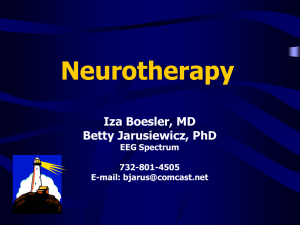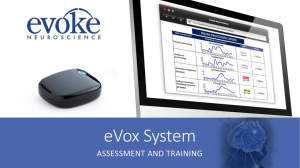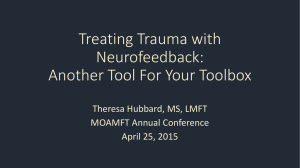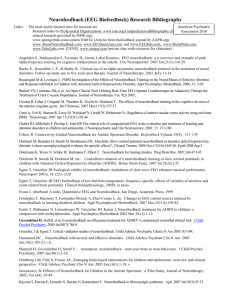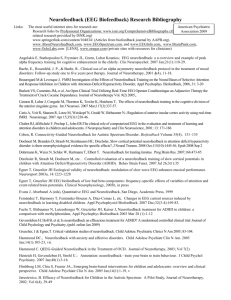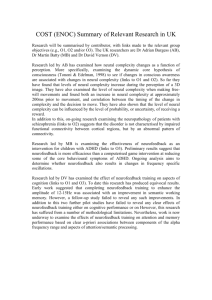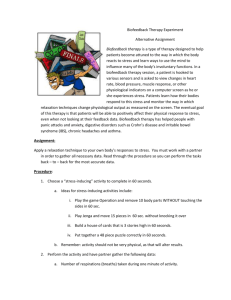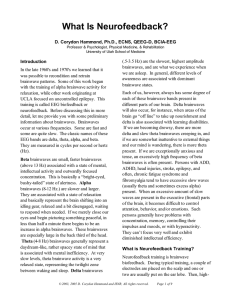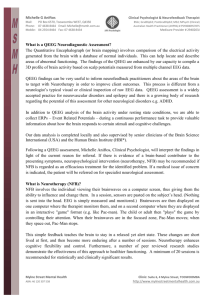to read this article by Dr. Mary Lee
advertisement
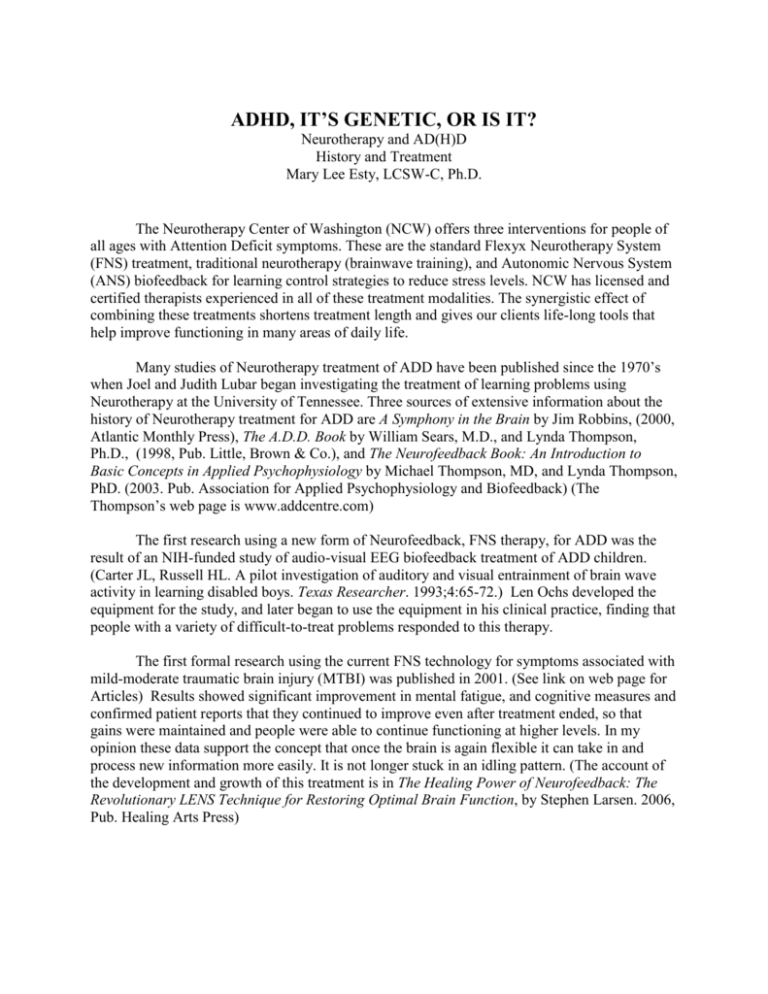
ADHD, IT’S GENETIC, OR IS IT? Neurotherapy and AD(H)D History and Treatment Mary Lee Esty, LCSW-C, Ph.D. The Neurotherapy Center of Washington (NCW) offers three interventions for people of all ages with Attention Deficit symptoms. These are the standard Flexyx Neurotherapy System (FNS) treatment, traditional neurotherapy (brainwave training), and Autonomic Nervous System (ANS) biofeedback for learning control strategies to reduce stress levels. NCW has licensed and certified therapists experienced in all of these treatment modalities. The synergistic effect of combining these treatments shortens treatment length and gives our clients life-long tools that help improve functioning in many areas of daily life. Many studies of Neurotherapy treatment of ADD have been published since the 1970’s when Joel and Judith Lubar began investigating the treatment of learning problems using Neurotherapy at the University of Tennessee. Three sources of extensive information about the history of Neurotherapy treatment for ADD are A Symphony in the Brain by Jim Robbins, (2000, Atlantic Monthly Press), The A.D.D. Book by William Sears, M.D., and Lynda Thompson, Ph.D., (1998, Pub. Little, Brown & Co.), and The Neurofeedback Book: An Introduction to Basic Concepts in Applied Psychophysiology by Michael Thompson, MD, and Lynda Thompson, PhD. (2003. Pub. Association for Applied Psychophysiology and Biofeedback) (The Thompson’s web page is www.addcentre.com) The first research using a new form of Neurofeedback, FNS therapy, for ADD was the result of an NIH-funded study of audio-visual EEG biofeedback treatment of ADD children. (Carter JL, Russell HL. A pilot investigation of auditory and visual entrainment of brain wave activity in learning disabled boys. Texas Researcher. 1993;4:65-72.) Len Ochs developed the equipment for the study, and later began to use the equipment in his clinical practice, finding that people with a variety of difficult-to-treat problems responded to this therapy. The first formal research using the current FNS technology for symptoms associated with mild-moderate traumatic brain injury (MTBI) was published in 2001. (See link on web page for Articles) Results showed significant improvement in mental fatigue, and cognitive measures and confirmed patient reports that they continued to improve even after treatment ended, so that gains were maintained and people were able to continue functioning at higher levels. In my opinion these data support the concept that once the brain is again flexible it can take in and process new information more easily. It is not longer stuck in an idling pattern. (The account of the development and growth of this treatment is in The Healing Power of Neurofeedback: The Revolutionary LENS Technique for Restoring Optimal Brain Function, by Stephen Larsen. 2006, Pub. Healing Arts Press) WHAT DOES MILD TRAUMATIC BRAIN INJURY HAVE TO DO WITH ADD? DOESN’T ADD HAVE A GENETIC ORIGIN? There is substantial overlap in the symptoms that are diagnostic for both MTBI and ADD. These commonly include some or all of the following: trouble with attention and concentration, short-term memory, organizing/prioritizing, impulsiveness, multi-tasking, and occasionally poor social skills and mood swings. These observations are supported by hard quantitative data from brain imaging studies with children and adults diagnosed with ADHD. Single photon emission computed tomography (SPECT) and positron emission tomography (PET) scan studies show decreased metabolism in many areas of the brain that are involved in various cognitive processes including attentional, inhibitory, and decision making behaviors. ADHD subjects typically make more errors in processes that require inhibition. It is important to note that similar findings are found in brain scans of those with mild-moderate TBI. Dr. Daniel Amen, neurologist, writes about functional brain problems revealed by SPECT scans in his book Change Your Brain, Change Your Life, (1998). “ADD occurs as a result of neurological dysfunction in the prefrontal cortex (pfc) . . . . . when people with ADD try to concentrate, pfc activity decreases rather than increasing as it does in the normal brains of control group subjects.” (p 116) Dr Amen saw that brain patterns on scans could detect abnormalities that interfere with behavior. “These brain abnormalities sabotage my patients’ efforts to improve their lives and send interrupt signals to the changes they try to make. I have seen how correcting (normalizing) abnormal brain function can change people’s lives, even their very souls.” (p 7) Neurotherapy practitioners use data from brain scans and Quantitative EEGs (QEEG) as a guide to treatment planning. The Neurotherapy Center of Washington also does a map of the brain activity (EEG) using the standard neurological sites to determine where imbalances in function are occurring. This map is much less expensive than a SPECT or QEEG and is also clinically useful to our patients. DOES EEG BIOFEEDBACK HELP? In 2002 a controlled study of ADHD children 6 – 19 years old confirmed clinical observations of experienced neurotherapists who have treated many people diagnosed as ADHD. (Monastra, 2002) The researchers compared brain wave activity of two matched groups of children. Both groups received Ritalin, parent counseling, and academic support at school. Only one group received EEG biofeedback. All testing was done after a medication washout period so all data were taken in a medication-free state. Teachers and parents throughout the study evaluated both groups systematically, along with other standard measures. Two questions the researchers asked were whether there were positive changes in brain function after Ritalin was discontinued, and whether the EEG biofeedback treatment produced a lasting change in brain function. Data collected at one-year follow-up was statistically significant for both groups, documenting positive results for the EEG biofeedback group, and no change for the Ritalin group. “Despite a year-long pharmacological treatment the neuropsychological effects of Ritalin were eliminated when patients were tested without medication at 1-year follow-up.” “In essence stimulant therapy would appear to constitute a type of prophylactic intervention, reducing or preventing the expression of symptoms without causing an enduring change in the underlying neuropathy of ADHD.” The students “who received EEG biofeedback as part of their treatment program exhibited increased cortical arousal on the QEEG. In contrast with the (Ritalin) group, the behavioral, neuropsychological, and electrophysiological improvements in the (biofeedback) group were maintained following a medication ‘washout’, suggesting that the used of EEG biofeedback impacted on the underlying neuropathy of ADHD.” “At present the only type of behavior therapy that has been associated with sustained improvement of core ADHD symptoms in the absence of stimulant therapy has been EEG biofeedback.” (pp 244 – 246) The researchers were surprised at the lack of significant improvements in those taking Ritalin. Even though parents and teachers opinions were that the Ritalin had helped, the quantitative data showed “a persistence of ADHD symptoms” in this group. “Overall, the results of this study are consistent with an emerging neurological model of ADHD. . . . our findings support the hypothesis that there are neurophysiological factors that contribute to the maintenance of this disorder.” No improvements were found in the symptomatic behavior of those whose brainwave patterns did not change when medication was stopped. Only those who received EEG biofeedback had changes in brainwave patterns, and these were still present at the one-year follow-up. These brainwave changes were associated with continued improvement in symptoms only for those who received EEG biofeedback. WHAT ROLE DOES MILD TRAUMATIC BRAIN INJURY PLAY IN ADD? Research funding received at the NCW has resulted in extensive experience with persons with TBI, many diagnosed with ADD. It is this background that supports the observation that a history of TBI is a major factor in producing the symptoms of ADD. It is our opinion that TBI plays a major contributory role in the onset of symptoms. There may be a genetic vulnerability in some cases, but minor head injuries are very common (see below) and yet raise less concern because there are no visible markers of aftereffects. For example there are two levels of concussion before loss of consciousness, so in the hustle of daily living we do not get too concerned by the tumbles, falls, and accidents that are virtually inevitable in childhood. While any one fall or car accident may not be significant in itself, the physical effects of such incidents are cumulative. Dr. Amen addressed the issue of the effect of mild brain trauma saying, “Minor injuries that leave brain tissues grossly intact may nonetheless cause perfusion abnormalities that can be seen on SPECT for extended periods, even if the patient never lost consciousness.” (From NeuroPsychiatry Reviews, (2001) Vol. 2(1) Feb. Especially important to know is that the two age groups at highest risk for TBI are those from birth to five years and 15 to 19 years. The leading causes of reported TBI are falls (28%), and motor vehicle accidents (20%). (www.biausa.org) The significance of these dry statistics in a discussion of ADD problems is that there are long-term consequences for TBI occurring in childhood. From birth to five years of age the brain is undergoing intensive developmental activity. Pathways are being formed. This is the worst time to have a head injury when the brain is building its pathways according to Ronald Savage Ed.D., a specialist in brain injury and Executive Vice President for the Bancroft Neurosciences Institute, New Jersey. In a survey of pediatric brain injury using data from the National Pediatric Trauma Registry it was found that the largest number of injuries occur between birth and 4 years of age with boys incurring injury more often than girls. (Savage, R. Epidemiology of Children with TBI Requiring Hospitalization. Brain Injury Source, Winter 20002/Spring 2003. p 8-13) While these data are drawn from children who were hospitalized is it very important to remember that there are many more injuries that are not reported, injuries that over time have consequences. Perhaps TBI should be considered an environmental-developmental disorder. Following a blow to the head, or a whiplash-type incident, a child cries and then seems to be all right. It seems that there is no problem. But the young child does not have to go to the office, process information in a timely fashion, and use executive functioning skills to complete tasks. For the young child there is no clear standard to evaluate possible change. However there is increasing awareness among neurologists who are following TBI research that when the child gets to 3rd or 4th grade the demands on a wide variety of executive functioning skills often lead to the label of ADD. “… latent effects of a childhood brain injury can emerge over time and cognitive challenges may develop as the child progresses in school.” (Lash, M, DePompei, R., 2003, The Right to Know: Educating Families When a Child has a Brain Injury. Brain Injury Source pp. 20 – 24, spring issue.) A study at the Kessler Rehabilitation Institute by Ricker in The APA Division of Clinical Neuropsychology Newsletter # 40 Winter/Spring 2002, “Clinical Implications for Functional Neuroimaging in Traumatic Brain Injury”, found that “The majority of SPECT and PET studies in individuals with brain injury indicate decreased brain metabolism or decreased blood flow, with disproportionately decreased resting activity in the frontal lobes.” This is consistent with other imaging findings in children with ADD. The prevalence of brain injury can be likened to a silent epidemic. In a study of college students 50% of 633 university men, and 33% of 863 university women had at least one instance of loss of consciousness during childhood as a result of a blow to the head. (In Perceptual Motor Skills, Oct.1985(2) pp 445 – 446) Of the 1.5 million who sustain a reported TBI each year in the United States 1.1 million are treated and released from an emergency department. The Brain Injury Association of America reported that there are more than 10 times the number of reported brain injuries annually than cases of breast cancer (176,300), HIV (43,681), Spinal Cord injuries (11,000), and Multiple Sclerosis (10,400) combined. As shocking as these figures are it is important to remember that these data cover only reported TBIs. The number of people with MTBI who are not seen in an emergency department is unknown. But the consequences of a “Mild” TBI are not mild in effect on daily life. They can be life altering. WHAT IS A CONCUSSION? A Grade 1 concussion is characterized by a short period of confusion lasting up to 15 minutes. Grade 2 lasts more than 15 minutes with some amnesia involved. Grade 3 starts with any loss of consciousness, even if only a few seconds. Brain imaging studies show that functional problems can exist even in the absence of any anatomical problems shown on a CT scan. (A CT scan gives only gross structural information. It cannot distinguish a live from a dead brain.) Any time there is enough momentum that the brain bounces and/or twists inside the skull as it comes to a sudden stop, some impact will be left on the cells and the chemical functioning of the brain. Sports injuries are very common and many school systems are now paying attention to the problems of mild injuries and their potential effect on academic performance in addition to acute health issues. Most of our child and adult clients with ADD symptoms have a known history of TBI, yet had never been asked about such incidents in relation to their symptoms. Often we have established that the problems they are seeking help for started shortly after an event involving mild concussion. The interest in injuries from sports activities has largely been spurred by the research efforts of the National Football League to reduce incidence of concussion in their players. “Your brain doesn’t care if it’s going from speed to no speed or from no speed to speed. . . It’s the sudden change in velocity that’s devastating.” Writes Eric Levin in an article entitled “Shock Absorber” in Discover Magazine, October 2004. For more on the effect of concussion related to sports injuries see “Lights Out: Can contact sports lower your intelligence?” (Barry Yeoman, Discover Magazine December, 2004. Pp 68 – 73). The effect on players in school sports can have a profound effect on academic achievement. NEUROFEEDBACK CAN IMPROVE FUNCTIONING IN MULTIPLE AREAS OF LIVING Improving the ability to focus impacts more that just academic performance. The world of sports is beginning to use the power of neurofeedback at the professional levels. “Members of Italy’s World Cup-winning soccer team have done it (neurofeedback). “Long used to treat medical condition such as attention deficit disorder, epilepsy and dementia, it is beginning to emerge as a tool for pro and amateur athletes alike. . .” (From the World Cup to youth tennis, a training fad emerges; The science of finding the zone. By Russell Adams, Wall Street Journal, July 29, 2006; Page P1.) Brain chemistry affects behavior and the electrical activity of the brain is an accurate indicator of brain chemistry. For this reason we use mapping of the electrical activity of the brain to aid in deciding if FNS treatment &/or traditional neurotherapy is appropriate for an individual, and as a guide during treatment. The evaluation process helps to record imbalances in brain functioning and is essential to treatment planning. Treatment planning is based on the information gathered in the history, and the EEG data, with modifications occurring as treatment progresses and provides new information. We approach each session as a part of an ongoing evaluation process. The brain itself is a part of this treatment team because, fortunately, it is extremely plastic. This means it is capable of change, often to a surprising degree, when given appropriate information, pushing, and guidance. Medication-free improved functioning is possible with neurofeedback treatment. Frank Duffy, M.D., Professor and Pediatric Neurologist at Harvard Medical School, says scholarly literature suggests that neurofeedback “should play a major therapeutic role in many difficult areas. In my opinion, if any medication had demonstrated such a wide spectrum of efficacy it would be universally accepted and widely used.” “It is a field to be taken seriously by all”. (Frank Duffy, Editorial: The state of EEG biofeedback therapy [EEG operant conditioning] in 2000: An editor’s opinion. Clinical Encephalography. 31(1):v-viii,2000.) Jonathan Walker, MD, a neurologist in Dallas, Texas says, “ In addition to treating illness, neurofeedback can help in improving mental and athletic performance in healthy persons. I love this approach to helping my patients. Often, the patient no longer has the problem or can control it without help from doctors, drugs, or any other treatment. Side effects are extremely rare (the occasional tension headache from trying too hard). In my opinion, neurofeedback and other electromagnetic techniques (audio-visual entrainment, colored light therapy, EEG/photic entrainment, and many others) will largely supplant drugs and surgery in treating our patients in the future. If you are involved or plan to become involved in this type of treatment, you are riding the wave of the 21st century.” A Neurologists Advice for Mental Health Professionals on the Use of QEEG in Neurofeedback. Jrl. Of Neurotherapy,(2004) Vol 8(2)98. Neurofeedback has a positive track record for helping those with ADD problems. It offers a non-invasive, non-toxic program for improving functioning in more than one area of life. Our goal is to make life easier in whatever areas are problematic for any person. There are no guarantees of positive outcome, but we want to provide the most appropriate clinical approach possible with compassion and understanding. Sharing concerns and questions is integral to the process so we welcome questions and also seek involvement with the other members of our clients’ treatment team. END NOTES Brain Imaging The findings from brain imaging studies support the existence of overlap of TBI and ADD brain functioning patterns in both diagnostic categories. One is a study by Beauregard, M. & Levesque, J. 2006. Functional Magnetic Resonance Imaging Investigation of the Effects of Neurofeedback Training on the Neural Bases of Selective Attention and Response Inhibition of Children with Attention-Deficit/Hyperactivity Disorder, Applied Psychophysiology and Biofeedback, Vol.31(1)3-20.. March. Another is a study done at St. Vincent’s Hospital and Medical Center and NYU Medical Center in New York City: (Abu-Judeh, H.H. et. al., SPECT Brain Perfusion Findings in Mild or Moderate Traumatic Brain Injury, 2000, Alasbimn Journal 2(6)January) The Beauregard study is especially compelling because the findings suggest that neurofeedback “…has the capacity to functionally normalize the brain systems mediating selective attention and response inhibition in AD/HD children.” (p. 3) Scans were done on experimental and control groups before and after treatment. Monastra, V, Monastra, D., George, S. (2002) The effects of Stimulant Therapy, EEG Biofeedback, and Parenting Style on the Primary Symptoms of Attention-Deficit/Hyperactive Disorder. Applied Psychophysiology and Biofeedback. Vol.27, (4) 231-249,Dec.

